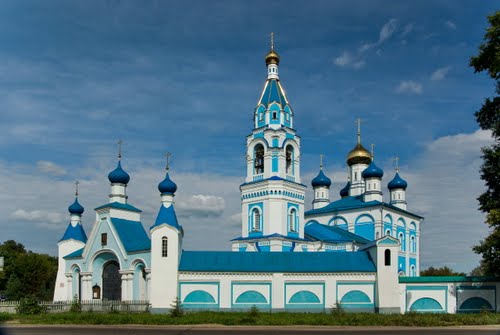

OPERATING MODE
Daily from 8:00 to 18:00. Please see the text
below for information on the schedule of services.
TICKET
PRICE
Free.
PHONE (PHONE)
8(4932) 30-87-66
PHONE FAX)
8(4932) 30-06-48
OFFICIAL SITE OF THE CHURCH OF THE
TRANSFORMATION IN IVANOVO
http://sobor-ivanovo.prihod.ru
Email:
ivsobor@gmail.com
The Transfiguration Cathedral is an Orthodox church in Ivanovo, located on Sovetskaya Square. It is one of the city's key architectural and historical landmarks, built in the eclectic style with elements of the pseudo-Russian style. The cathedral serves as the cathedral of the Ivanovo-Voznesensk Diocese of the Russian Orthodox Church.
The laying of the temple took place on August 27, 1889. The church
was built within four years at the expense of the manufacturer M. N.
Garelin and was solemnly consecrated on August 24, 1893.
The
project of the church was developed by the famous Moscow architect
Alexander Stepanovich Kaminsky. The facades of the main volume of the
temple are completed with kokoshniks, and the corners - with hipped
turrets. The temple is crowned with an octagon with five heads on high
faceted drums. Lush architraves and cornices, two-tiered kokoshniks and
other architectural details give the building an elegant appearance. On
the western side, a high hipped bell tower adjoins the temple, where 12
bells were originally placed. Three entrances to the temple are marked
with hipped porches.
Many details of the decoration of the church
are borrowed from the architecture of the late 17th century. Not far
from the main entrance to the temple, a two-story brick house of the
clergy was built. In the central part of the temple, a three-tier
iconostasis was installed, and in the aisles of the Martyr Nikon and the
Iberian Icon of the Mother of God, two-tier iconostasis, made according
to the drawings of Alexander Stepanovich Kaminsky. The icons for them
were painted by the Moscow artist Ya. I. Ruchkin.
In addition,
several ancient, richly decorated icons were transferred from the
Garelins' home chapel to the temple. The wall painting in the temple was
made by the artist I. V. Belousov. Subsequently, M. N. Garelin and his
wife were buried in the courtyard of the church against the altar.
Initially, the Church of the Transfiguration was designed for 700
people - residents of the village of Rylikha, which existed on the
outskirts of Ivanovo from the beginning of the 17th century. After the
construction of the temple, it became known as the village of
Preobrazhensky and became part of the city after the February Revolution
of 1917.
Since 1931, the temple has been used simultaneously by
two Orthodox communities - traditional and renovationist - who moved to
the Church of the Transfiguration from the closed Pokrovsky Cathedral,
and then from the Assumption Cemetery Church. This use of the temple led
to constant conflicts.
By the decision of the regional executive
committee on May 19, 1940, the church was closed, the interior
decoration was destroyed. Two years later, the believers applied for
registration of the Orthodox community, and on November 17, 1944, divine
services resumed in the church.
After the creation of the
Ivanovo-Shuya, then the Ivanovo-Kineshma diocese, the Church of the
Transfiguration became a cathedral.
The side aisles were
consecrated in honor of Nicholas the Wonderworker and the Kazan Icon of
the Mother of God. Wall paintings and interior decoration were recreated
in the post-war period. The carved gilded iconostasis in the Baroque
style was brought in 1956 from the village of Sarajevo, Furmanovsky
district. This village belonged to A.V. Suvorov in the 18th century.
The cathedral is a five-domed structure, approximately 55 meters high, with a central dome on a high drum. The architecture combines elements of classical, baroque, and ancient Russian architecture: the facades are decorated with white stone details, arches, and kokoshniks. Construction was funded by philanthropists, including textile manufacturers. The primary material is brick faced with plaster. The interior includes a main nave, an altar, and side chapels dedicated to saints.
The cathedral's interior is richly decorated: the walls and vaults are painted with frescoes depicting biblical scenes, created in the early 20th century by Moscow artists. The central iconostasis is five-tiered and carved, displaying Byzantine-style icons. The church houses relics, including the icon of the Savior Not Made by Hands and locally venerated icons. Interior restoration is ongoing, restoring lost frescoes.
The cathedral is located in the center of Ivanovo, on Sovetskaya
Square (formerly Revolution Square), opposite the House of Soviets. This
is the central part of the city, where fairs and public events have
historically taken place. Notable Events
The cathedral has witnessed
key events: in 1913, the 300th anniversary of the Romanov dynasty was
celebrated here. During the Great Patriotic War, the church was closed
but escaped complete destruction. In the post-Soviet period, it hosted
significant services, including the visit of Patriarch Alexy II in 2000.
Today, the cathedral is a place of pilgrimage and hosts festivals such
as the Nutcracker Music Festival.
The cathedral is designated a federal cultural heritage site. It can accommodate up to 3,000 people and is equipped with modern lighting for evening services. The Ivanovo History Museum is located next to the cathedral, making it a popular tourist destination in the city. Thousands of tourists and believers visit the cathedral annually, interested in its role in the history of Russia's textile hub.